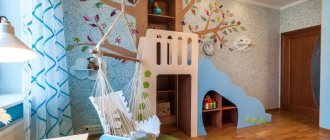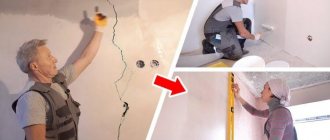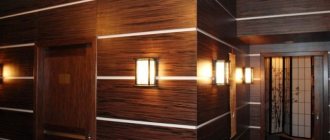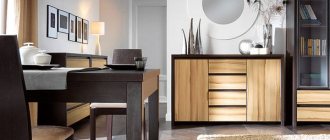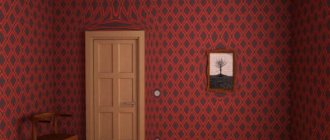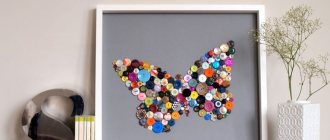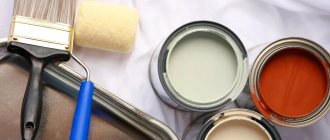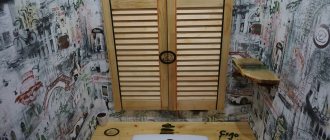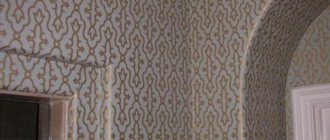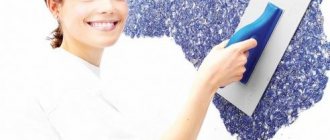Wet wallpaper is a decorative plaster based on cellulose fibers. Wet wallpaper is a kind of excellent combination of conventional wallpaper and decorative special plaster. This type of wallpaper is used for both walls and ceilings. This is a certain dry substance that needs to be diluted with water before applying it to the walls. Due to the fact that this mixture contains certain decorative components, such wallpaper simply looks great on the walls. There are several different types of wet wallpaper, such as cellulose, silk, and silk-cellulose.
What is liquid wallpaper?
Wet wallpaper is a term more common than professional. It arose from purely practical properties, combining the advantages of wallpaper, putty and decorative plaster. Although, unlike the last finishing material, wet wallpaper does not contain sand. Another name for them is silk plaster. In the language of designers and manufacturers, such wallpaper is called liquid.
Basic composition: cotton or silk fibers with cellulose, dyed with natural dyes. The color scheme is suitable for creating a background in any room.
It is important to consider that after application the surface of wet wallpaper looks darker than when dry.
Surfaces suitable for decoration:
- Concrete.
- Plaster.
- Drywall.
- Metal, wood or plastic - only after priming.
It is acceptable to apply wet wallpaper after painting.
Manufacturers:
- Leroy Merlin (France). They produce elastic, high-quality wet wallpaper for walls.
- SilkPlaster (Russia). Excellent moisture resistance. They withstand temperature changes well.
- Bioplast (Lugansk).
- Poldecor (Poland).
- Silkcoat (Japan).
- Casavaga (Russia).
World leaders in the production of liquid formulations also operate in Poland, Turkey, Iran and China.
Types of wallpaper for walls: wet and rolled
The term "wallpaper" originated in China. This is associated with the discovery of rice paper and, as a result, wall coverings to decorate rooms. Today, “wallpaper” is most often associated with a rolled finishing material that is used for finishing wall decoration.
The highest quality and most expensive type of finishing is non-woven wallpaper.
Main types of rolled wallpaper:
- Paper. For this type of finishing, paper and cellulose are used.
- Vinyl. A type of roll covering, the base of which consists of paper or non-woven fabric, and the surface layer is made of polyvinyl chloride.
- Non-woven. Wallpaper based on non-woven fabric.
- Textile. Wallpaper consists of a paper (non-woven) layer and a fabric base: silk, linen, felt, velor, jute.
In addition to traditional roll wallpaper, there are wet or liquid wallpaper, as they are also called. Wet wallpaper is rather a common term that was formed as a result of the fact that this type of finishing combines the advantages of plaster, wallpaper and putty.
Recently, decorating walls with traditional wallpaper has become less and less popular. Conversely, original wet wallpaper, due to fashion trends and operational advantages, is becoming increasingly popular.
Types of liquid coatings
Wet wallpaper is divided according to its composition into 3 large groups.
- Silk. High percentage of natural silk. The release composition is liquid or powder. Excellent application on concrete and drywall, easily repairing damaged fragments. The most expensive and high-quality category of wet wallpaper.
- Cellulose. Wood processing products are added to the mixture. A particularly suitable material for cold rooms without heating. In apartment conditions, it is better to use it in hallways and corridors. Perfectly masks microcracks.
- Cotton. Approximately 99% pure material. The rest is additives of mica, other decorative compounds and cellulose glue. Warm tactile sensations.
Mixtures for application to walls are produced in the form of dry powder (in bags) or liquid in buckets. The dry powder comes with decorative additives, maybe silk threads, glitter or something else. Silk provides the visual effect of the fabric, threads of golden or silver glitter, marble chips or mica sparkles emphasize the decorative nature of the coating.
For proper application to walls, dry powder is diluted with water. The technology for working with ready-made mixtures is much simpler.
Creating a pattern with liquid wallpaper on the wall with your own hands
By decorating walls with wet wallpaper, you can create all kinds of designs. It’s worth turning on your imagination. For this you don’t need to be an artist, you just need to understand the simple technology of action. Is fine art not your thing? Don't be upset. Create a template, then stick it to the wall in the location where you want the design. Use a pencil to transfer the design onto the finishing surface. This makes it possible to create any, even complex, sketch. After preparing the coating, you can begin to get creative - create a pattern using liquid wallpaper. This principle allows you to create patterns on the walls using wet wallpaper.
Once you complete the task, you will save a lot of money, since the cost of professional work is not cheap. And the more expensive the finishing, the more complex the patterns.
By decorating walls with wet wallpaper, you can create all kinds of designs.
Useful properties and disadvantages
Like other wall covering materials, liquid wallpaper has its advantages and disadvantages. Before using them in repairs, it is worth assessing all the pros and cons of such finishing.
Advantages:
- Low flammability.
- Harmless to health.
- Masking properties.
- No seams or joints.
- Antistatic.
- Protection from mold and mildew.
- Simple application and repair technology. Can be removed and reapplied up to 6 times.
- Breathability.
- Resistant to fading.
- The ability to create “paintings” with your own hands and apply them to walls and ceilings.
- Reduces noise.
- Does not retain odors.
- Keeps you warm.
- When applied to pipes, it prevents them from being damaged by rust.
- Calmly relates to temperature changes.
- Easy to apply anywhere.
- Has a luxurious appearance.
Flaws:
- Without varnish, it quickly absorbs water.
- Upon contact with other surfaces and objects, the finish will be wiped off.
- After varnishing it becomes hard and does not allow air to pass through well.
- It takes a long time to dry, up to 2 days.
- High price.
The advantages of wet wallpaper significantly outweigh its disadvantages, so using such finishing materials with the proper skill is a pleasure.
Liquid wallpaper consumption
What is the price and consumption of liquid wallpaper per square meter? Experts recommend spending an average of 1 sq.m. 0.5 kg of dry composition. The purchase price directly depends on the area of the room and the presence of external effects.
For an even surface you will need from 0.3 to 0.5 kg. It is also necessary to take into account the inclination and movements of the spatula during the application of the working composition to the walls. For example, if you hold a construction spatula at an angle of 45 degrees, then approximately 0.2 kg will be consumed during application.
Note!
Glass wallpaper - what is it? Pros and cons, types, features, characteristics, photos of design and combinations in the interior
Plain wallpaper - 150 photos of modern design. Rules for choosing and combining wallpaper in the interior: kitchen, bedroom, living room, hallway
Wallpaper framed on the wall in the interior: photos of original design and beautiful decor
Surface preparation and application of composition
Wet wallpaper for walls can be applied to any surface, but if you want it to look perfect, it is better to carry out the preparatory stage.
- Remove or wash off the old coating.
- If the wall is painted, clean off the paint that has come off the walls.
- Paint over metal “impregnations” in the wall with oil paint.
- “Cover” the voids with putty, level the surface and dry.
- Prime. If the surface is too smooth, use a primer with quartz dust. Dry again.
- Re-prime.
For priming, it is important to use compounds that best match the wall base:
| Wall surface | Recommended primer type |
| "From under the whitewash." | For 3 kg of fluff, a piece of high-quality laundry soap and 100 g of drying oil. |
| Under oil paint. | Waterproof primer. Do it in 2 layers. |
| Metal. | White water-based enamel. |
| Plastic. | Composition containing PVA glue. |
| Plain concrete | Deep penetration primer. |
To get started you will need: a container for diluting the mixture, a spatula for liquid wallpaper, rollers, a grater with a smooth surface, a primer. The spray gun will greatly simplify the work.
Preparation of the liquid mixture
Ready-made wet mixtures are offered in buckets, the rest - in bags. Stores sell wallpaper of three types:
- Dry.
- Dry, but with added color and texture.
- Liquid, completely ready for application.
When calculating the material, it is important to be careful! Manufacturers indicate the material consumption for a perfectly flat surface in a layer of just over a millimeter. It is better to purchase wet wallpaper with a reserve.
Preparation technology:
- Most often, 1 packet is diluted for a full bucket of warm water (not with the top on).
- The wallpaper is poured gradually, mixing well and removing lumps. Add dye in the same way (if desired). If you plan to use glitter or colored powder, first sprinkle and stir them.
- Leave until it swells, usually according to the instructions, for 12 hours.
- After this, add a liter of water and stir vigorously.
- In the case of creating a pattern, each shade is prepared in its own container and, if necessary, mixed before final application.
- Apply quickly.
Applying the composition to surfaces
Covering walls or ceilings with a wet method seems quite unusual, but this is rather a psychological question. The main thing is to work carefully and clearly, then the technology for applying the liquid composition will not seem too complicated.
Common application technology:
- The solution is applied with a spatula or a special spatula.
- Level first with a roller, then with a trowel with a smooth surface in a layer of up to 5 mm. It is important to create a continuous line of the surface, without transitions.
- It is better to level each subsequent portion of the mixture towards the already treated area.
- The “drawing” of the surface is created with a structural roller immediately during work or 5 hours after its completion.
- Loads on the surface are possible no earlier than after 48 hours.
Some features of the work:
- When working with a spray gun, first apply a layer of 1.5 mm to the entire surface of the wall. After the layer has dried, the “procedure” is repeated. If you want to make a drawing, it should be created no earlier than 7 hours after the first layer has hardened.
- The ceiling, finished with a wet coating, can withstand adhesive elements of decorations.
- In the bathroom, after applying the composition, it is necessary to paint it with acrylic varnish in 3 layers. Dry each layer for 2 hours.
- Wallpaper of a wet structure with clearly defined fibers can only be applied manually.
An easy way to create a drawing:
- On the surface of the wall, the drawing is drawn with a pencil.
- With light “strokes” of the composition of wet wallpaper, what is drawn is outlined along the contour, but wider by about 2 mm.
- Using a small spatula, move the contour border exactly according to the drawing.
- The finished area is dried.
- After 2 millimeters from the dried “scheme”, a new contour is applied, already about half a centimeter thick. Fresh layers are shifted towards the dried ones until they touch. This establishes a clear border to the drawing.
- The main part of the “picture” is “painted over”.
The best material for drawings in terms of beauty and quality is wet wallpaper based on silk thread.
Restoration:
Restoration of a dry surface is carried out according to the following rules:
- Shallow scratches or dents are moistened with water and smoothed with a grater.
- A fairly badly damaged part of the coating is soaked generously with water and removed from the wall. If there was no coating such as varnish, the mixture is reapplied, smoothed and, if necessary, supplemented with a new layer on top. When any protective or decorative coating is applied on top of the liquid wallpaper, the damaged area of the “wet wall” is completely removed and replaced with a new layer.
Rules for preserving the durability of wet coatings
Wet wallpaper easily changes its structure under the influence of water. Therefore, the technology for preserving them in “working form” requires compliance with certain rules.
- The durability of walls finished using the wet method of applying wallpaper will only be ensured by a protective film or varnish. In this case, wet cleaning with a sponge is acceptable.
- The coatings can be cleaned with a washing vacuum cleaner.
- Small stains can be easily removed with a regular eraser.
Beautiful, modern wet wallpaper is incredibly in demand among lovers of non-standard design of their own homes. They can decorate any room in a house or apartment, surprising visiting guests with magnificent paintings. Allow yourself a little wild imagination to make life more fun!
